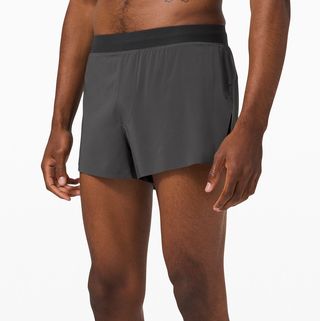Sure, pace and distance are important training tools. But the best runners don’t just rely on data—they learn to run by feel. Why? Because while pace is a numbers-based assessment of your performance, running by feel allows you to use information your watch can’t capture—the wind against your skin, the ground beneath your feet, your heart beating inside your rib cage—to provide a more holistic assessment of your miles.
The more you can dial into what your body has to tell you on a run, the easier it will be to stay focused on your goals and build your overall running comfort level. After all, the best runs are the ones where you’re barely even thinking about running—you’re just enjoying the moment. You can start by gearing up with lululemon’s “Fast and Free” collection, designed to help you forget everything else besides the run. Then, read on for RRCA-certified running coach Matthew Meyer’s favorite tips for running by feel.
Run by Feel with “Fast and Free” Essentials from lululemon




The lululemon “Fast and Free” collection is designed to help you feel closer to your run. With impossibly light, streamlined, highly breathable pieces, you’ll barely notice your gear so you can stay in the moment regardless of conditions.
Run naked. (No, not like that.)
Wearable devices are more popular than ever, but for as much information as they try to give you, they don’t know you. Trackers measure data points without context, cautions Meyer.
Did you drink last night? That could elevate your resting heart rate, which would make an easy pace feel harder. Did you get a good night’s sleep? If not, you might feel like you’re dragging, even at your daily easy pace. Stressed out from work? Piling that on top of exercise stress also makes working out feel harder. “No data point is more accurate than how you feel,” says Meyer.
And you can’t pay attention to how you feel if you’re fixated on your watch and “what the numbers say” about your performance. So ditch the tracker! Running sans tech allows you to better tune into yourself. “You’re going to learn way more from listening to your body than to a watch,” says Meyer.
Learn to gauge your effort level.
Your rate of perceived exertion (or RPE) is a tech-free way for you to gauge how hard you’re working during your runs. It’s a scale of 1 to 10, where 1 to 3 represents an easy level of effort (not much more strenuous than walking), 4 to 6 is more moderate (you’re moving but can hold a conversation without gasping for air), 7 to 9 is hard (you’re working too much to chit chat), and 10 is your max (you’re sprinting all-out for the finish line). Yes, you’re still using numbers—but it’s not about pace!
“No data point is more accurate than how you feel.”
Maybe you cruised through a killer speed workout, but your easy long run the next day felt like a slog—even if your paces are at opposite ends of the spectrum, you might rank them both at an RPE of 8 because of how hard they felt. The lesson there? You might need some extra recovery after track days.
“There are days when it feels like I have to sell my soul to run an eight-minute mile pace, and [others I feel like] I can run a 5:30-mile pace for a marathon,” says Meyer. Pace on a watch is an objective piece of data that comes from a satellite measuring your speed; RPE is more subjective, and a better tool to help keep you from mentally getting tripped up when “fast” or “slow” paces don’t sync with how you felt that day.
Listen to your body. Like, really listen.
Most any coach will tell you the majority of your miles should be done at a conversational pace—meaning, you should be able to hold a conversation without feeling like you’re sucking wind, says Meyer. If you hear yourself gasping and wheezing, you’re probably running too fast for that effort.
“You’re going to learn way more from listening to your body than to a watch.”
Once you learn what feels conversational, you can start using your breath to determine faster efforts, too. If you can still talk in short spurts, that’s pretty moderate, while breathing heavily and barely being able to talk is a harder effort. The only time you should be gasping for breath is during an all-out, final stretch effort. When you do find yourself getting short-winded, “pause, take 10 deep breaths, and relax,” says Meyer—that’ll help you get back in the moment.
It’s not just your breath that can tell a story. “Listen to the sound of your feet touching the ground,” says Meyer. “Are you nice and light? Or do you sound kind of clunky and flat-footed?” The latter can be a sign of fatigue or that your form is suffering (which can make running feel harder).
Play with speed—without a track.
When running by feel, the best type of workout you can do isn’t on the track, it’s something called a fartlek, says Meyer. Fartlek is Swedish for “speed play,” and it means exactly that: alternating bouts of hard efforts and recovery periods within a bigger run.
“You might need to rethink your concept of what feels easy or hard to you.”
That could look like 10 repeats of 40-second pick-ups followed by one minute of recovery, or simply running hard for one block and jogging the next block, says Meyer. This type of interval training helps you find consistency within the reps—after you get a few under your run belt, each effort and recovery will start to feel like more familiar territory.
And yes, it’s fine to wear a running watch. Just try to wait until after you finish to check your paces. “If your numbers agree with the type of effort you were giving, great,” says Meyer. “If they say something different than what you were expecting, that might mean you need to rethink your concept of what feels easy or hard to you.” For the totally tech-averse, an old-school running journal—using the RPE you felt that day—can help you reflect on the workout and track trends over time.
Source: Read Full Article
